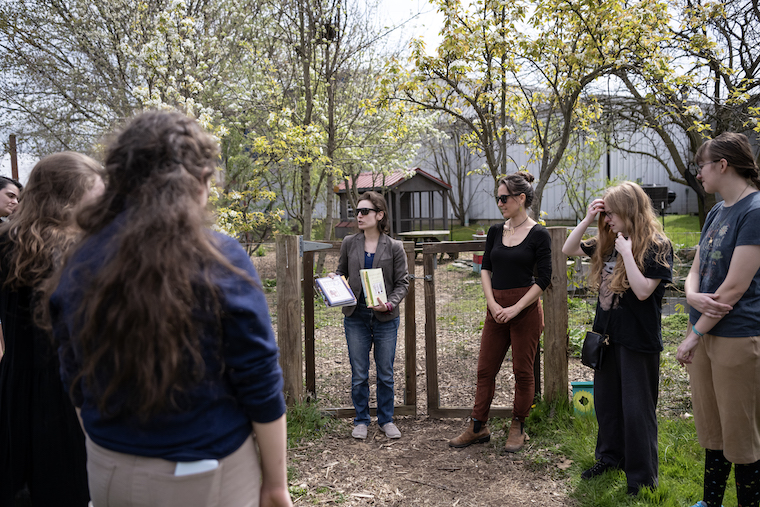What to Plant in Your Garden, According to Chaucer
Newly launched Poetry in the Garden course turns Washington’s Campus Garden into an interactive outdoor learning space for students and plant-loving community members.

Spring is well underway on the Eastern Shore and students enrolled in the newly offered English 301 course have found themselves out in the campus garden tending to plants as they read aloud from Geoffrey Chaucer's magnum opus, “The Canterbury Tales.” The goal of the course is to explore how the poetry legend used nature, specifically plants and herbs, to create a sense of place and symbolism in his writings. To bring this class to life, English Department Chair Courtney Rydel has partnered with Campus Garden Director and Lifelong Learning and Communications Coordinator Shane Brill to have students build a Poetry Garden. The garden will serve as an outdoor classroom and learning space for future courses and projects.
“The idea was inspired by Dr. Rebecca Fox of the Environmental Science department, when she suggested we have a ‘Chaucer Garden' on campus,” said Rydel. Other partners in the unique, interdisciplinary effort include carpenter Reece Johnson, Garden Club members, and Mallory Westlund in Building and Grounds. Additionally, Assistant Director of Educational Technology Raven Bishop and the summer VARDIS fellows will use their technical expertise to create a virtual tour and website to accompany the garden. The course brings in students from the Washington College Academy of Lifelong Learning to assist in the planting alongside students and partner in discussions on the literature.
“Only at Washington College could a collaboration like this be possible, in which an idea in August becomes a reality by the next May,” raved Rydel. “The inclusion of the Lifelong Learners in our class has been the biggest boon, as their presence has enabled us to dig into the history of medieval gardens, Chaucer's own gardening experiences, the depiction of birds in his poetry, and the multifaceted use of plants in the "Canterbury Tales" to subtly send messages to readers ‘in the know.' Having gardeners and birders with decades of experience in the room with us has completely transformed the class, as we all learn from each other.”
 “In this class, we've focused a lot on building community and connecting with the
world around us through nature. I read a passage and then get to connect that to the
experience of using our senses to observe the plant, animal, etc. in our little corner
of the world,” said Melinda Kern ‘25. “Although Chaucer lived hundreds of years ago,
we have read this satire in an involved way that allows us to better understand the
lives and values of people of the past and reflect on our own.”
“In this class, we've focused a lot on building community and connecting with the
world around us through nature. I read a passage and then get to connect that to the
experience of using our senses to observe the plant, animal, etc. in our little corner
of the world,” said Melinda Kern ‘25. “Although Chaucer lived hundreds of years ago,
we have read this satire in an involved way that allows us to better understand the
lives and values of people of the past and reflect on our own.”
To celebrate this community building course that gives a deeper appreciation for the poetic plants in our gardens and their abilities to make us think about our lives and world in new ways, we asked Dr. Rydel to provide a list of flowers and herbs that carry significant meaning and lore. Below are her thoughts on what would be Chaucer's top picks for adding to your garden.
To follow this project along in real time, check out the Poetry Garden's webpage, which the Permaculture interns are keeping up to date. To learn more about the English Department's unique course offerings, head to their department webpage.
What to plant in your garden this spring, according to poetry legend, Geoffrey Chaucer
Geoffrey Chaucer, the “Father of English Poetry,” is best known for his "Canterbury Tales," but he was also an avid gardener. He tells us in “The Legend of Good Women” that he has “a litel herber” surrounded by benches covered with turf (lines 203-4). This “herber” would have been a garden of herbs, chosen both for eating and their medicinal properties, as well as perhaps plants he appreciated for their beauty and scent.[1] In "The Canterbury Tales," Chaucer's self-insert character remarks on his own love of “walking in the grene” (Prologue to Sir Thopas, lines 1886-7). At some point between 1390 and 1400, Chaucer served as a forester in North Petherton, Somerset, responsible for the maintenance of the royal forest there. Chaucer's close attention to the natural world is evident in the “Parliament of Fowls,” where he accurately reflects the behavior of real birds, often with more attention than some of the encyclopedic and “scientific” sources of the day.[2] Chaucer mentions in his works 47 trees and shrubs, 34 fruits and vegetables, and 49 herbs, for a total of 130 species that were grown in medieval England during Chaucer's day. [3] Throughout "The Canterbury Tales," characters walk in gardens, meet lovers in gardens, dance and play in gardens.
Here are some of the plants that Chaucer mentions in "The Canterbury Tales" that you can bring into your own garden at home!
 Briar. Chaucer compares the sharpness of thorny bushes to the prickling of an unwanted husband's
beard in the “Merchant's Tale.”
Briar. Chaucer compares the sharpness of thorny bushes to the prickling of an unwanted husband's
beard in the “Merchant's Tale.”
Daisy. Chaucer loved daisies so much that in “Legend of Good Women” he devoted fifty lines to his favorite flower! In the "The Canterbury Tales" General Prologue, the Franklin's beard is as white as the petals of a daisy.
Eglantine. Also known as sweet briar, this plant shares a name with Prioress Eglantyne, the head of a convent of nuns who joins Chaucer and her fellow pilgrims on their journey from London to Canterbury. She at first seems very sweet and lovely and refined, but proves to be selfish and consumed with secular, worldly things.
Garlic, Onions, and Leeks. All three of these savory vegetables were favorites of the vile Summoner, a corrupt church official. The resulting strong breath might have made him even less appealing to his fellow travelers!
Marigold. Heard of being green with jealousy? Well, that's Shakespeare's take on the emotion. Chaucer described jealousy as wearing a garland of yellow marigolds in the “Knight's Tale.”
Roses. Chaucer frequently compares beautiful women to roses. In the Knight's Tale, Emily blushes so prettily that the color in her cheek competed with the beauty of the rose.
Parsley. The Host criticizes the Cook for his ill-kept shop, where he reheats the same pies over and over to disguise how old they are and uses fresh parsley to conceal the defects of his “subtle goose.” Though the Cook uses parsley to duplicitous ends, fresh parsley is still a delightful garnish.
Willow. Alison, the Wife of Bath, reminisces about her fifth husband Jankyn comparing letting a wife go traveling unaccompanied to building a house out of the wood of the willow tree, a risky proposition. (Of course, Jankyn is now dead, and Alison does as she likes—hence this pilgrimage to Canterbury!) As long as you are not trying to use the slender willow for construction, it is a lovely addition to any garden.
- Dr. Courtney Rydel, Department of English Chair
--------------
[1] See John H. Harvey (1994) “Gardening in the Age of Chaucer,” Botanical Journal of Scotland, 46:4, 564-573, DOI: 10.1080/13594869409441764.
[2] See Jennie M. Carr and Courtney E. Rydel, “Medieval Birds: Science Meets Poetry in the Parliament of Fowls,” The Once and Future Classroom: Resources for Teaching the Middle Ages, 15.1, Fall 2018.
[3] H.N. Ellacombe, “The Flowers of Gower and Chaucer,” The Gardeners' Chronicle: a weekly illustrated journal of horticulture and allied subjects, 24 June-2 September 1911.